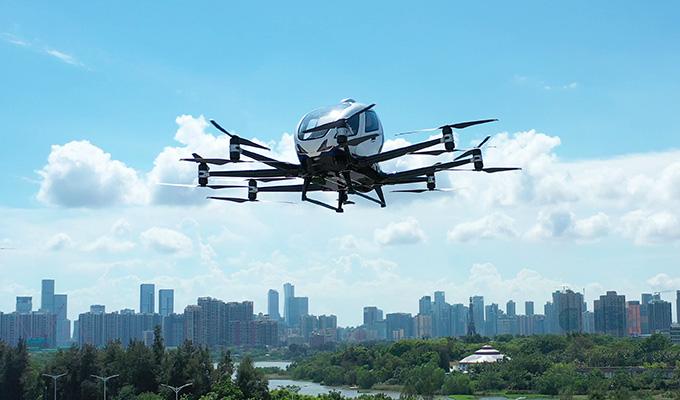
EHang’s EH216-S multicopter eVTOL.
EHang has climbed from No. 8 to No. 2 in the AAM Reality Index, fueled by ongoing progress toward achieving the world’s first certified passenger eVTOL.
Remaining at the top of the 10-point Reality Index is Joby Aviation (8.7), followed by EHang (8.1), Volocopter (8.0), Beta Technologies (8.0), Archer Aviation (7.8) and Lilium (7.8).
Sergio Cecutta, a partner with SMG Consulting and Aviation Week’s partner in providing the AAM Reality Index, says the rationale for EHang’s new position is based on expectations that the Chinese OEM will be the first in the world to certify a passenger electric vertical takeoff and landing (eVTOL) vehicle, with certification of its unmanned, two-passenger EH216-S from the Civil Aviation Administration of China now expected in January 2023.
“While it is true that it’s going to be a China-only vehicle, and while it will not be directly comparable to a vehicle like Archer’s [Midnight]—which is four to five times larger–we also need to contend with the fact that it will be the first AAM vehicle to be certified in the world for passengers,” Cecutta told the AAM Report.
“EHang has already made hundreds of these aircraft,” Cecutta added. “They’ve delivered 167 units to date, and they have a plant that can produce up to 600 units [annually]. It’s not making 600 units—but it can, and it’s already operational. So, it’s not like Archer or Joby where that plant is coming. This plant is up and running.”
Joining the AAM Reality Index for the first time is Alaka’i Technologies, with a score of 6.2. The Boston-based startup, which is developing the Skai–a piloted, hydrogen fuel cell-powered, five-seat multicopter–is the first-ever hydrogen-powered design to register on the AAM Reality Index.
“They actually have a full-scale vehicle flying and they’ve made a lot of progress, although they’ve been very quiet,” Cecutta said. “We thought that’s an important piece of the pie, because using hydrogen gives them an enormous amount of range.”
Another new entrant is Heart Aerospace, with a score of 5.1. The Swedish OEM, which is developing its electric 30-passenger ES-30 electric conventional takeoff and landing (eCTOL) aircraft, is targeting the short-haul regional air transport market, as opposed to the urban air mobility (UAM) market where most eVTOL companies have set their sights.
The ES-30’s conventional-wing design would also enhance its performance and range relative to other eVTOL startups.
“EVTOL is what the majority of the industry is concentrated on. However, if you add a wing and runway, that makes batteries last a lot longer, as far as range goes,” Cecutta said. “The whole idea of regional air mobility–serving places that have either reduced service or places that have lost service–is very interesting, especially if you consider the situation in Europe with the [flight-shaming movement].”
The AAM Reality Index is based on five elements: funding, leadership team, technology readiness, certification progress and production readiness.
SMG’s Infrastructure Readiness Index, which ranks providers of infrastructure to enable commercial AAM operations, was mostly unchanged in December from October’s report–although there was some minor reshuffling.
Vertiport management company UrbanV jumped to No. 5 in December from No. 7 in October, with an updated score of 5.9 out of 10–surpassing Skyports and BlueNest–boosted by recent partnership announcements.
French airport operator Groupe ADP retained the No. 1 ranking on the infrastructure index in December with a score of 6.7, followed by Beta Technologies (6.3), Ferrovial (6.3) and Urban-Air Port (6.3).





